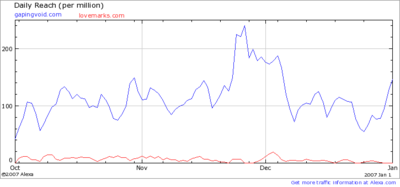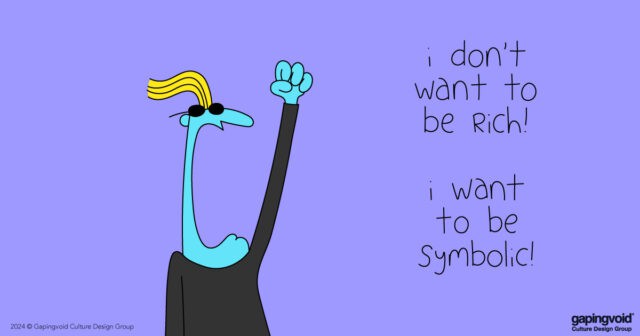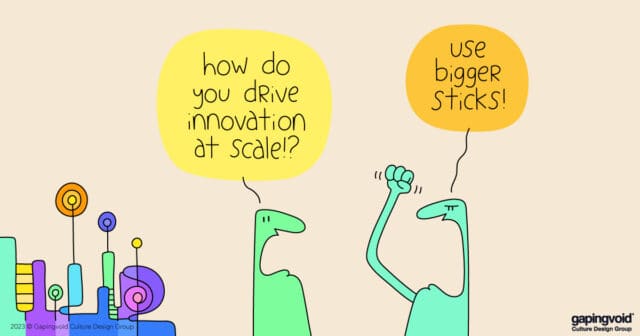
On the Saatchi & Saatchi Lovemarks homepage they have a little invite for readers to “Join the community”. Ummmm… Community? What community? [See chart above]
Two years ago I spent a bit of time panning the whole “Lovemarks” idea [e.g. “The Lovemarks-Cluetrain Deathmatch”]. So much so that I heard well-sourced rumors that I was allegedly pissing off some very senior people within the organization etc.
Now I see Kevin Roberts, CEO of Saatchi’s has come up with a sequel: “The Lovemarks Effect”. Fair enough. The first book, “Lovemarks”, was theory. This one, I understand, is more concerned with application.
No, I’m not going to start another anti-Lovemarks meme. Here’s why:
1. Though I might have issues with Saatchi’s advertising-centric execution, basically I think Kevin is right. Yes, in fact, all you need is love after all. That’s pretty much what I said at Le Web 3 last month:
This market and communication transition we’re going through is not about technology, and it sure as hell isn’t about marketing. It’s about Love. Love enabled. Love re-asserting itself in the business between people.
2. I’m not quite so “anti” advertising as I used to be. When all is said and done, advertising is just a subset of marketing. And all marketing is, is finding ways to sell stuff, better than your competition. And nothing wrong with wanting to make a living.
So I was grateful to Edelman’s David Brain for pointing me to a recent video interview of Kevin Roberts, where he talks about how The Love Thing affects what he does for a living, how it affects the future of branding etc. There is food for thought there, certainly.
Note how the official Saatchi’s line is now “We’re an ideas company, not an advertising agency”. Again, I think that is sound thinking. They’ve seen the writing on the wall, and they’re working like hell to evolve away from the big-media-world-domination model they grew up with, and towards something more useful and meaningful. With any luck, they’ll succeed, but only if they can understand “The Porous Membrane” idea, and not fall into the trap of “Bagelnomics”.
As I’m fond of saying, I believe the future of advertising is internal. It’s hard to get the customer to love the company, if the company doesn’t love the company.
Whether big companies like Saatchi’s can evolve fully into this new mindset, or whether they’ll be replaced by younger, hungrier companies that understand it better, only time will tell. But the market for selling isn’t going anywhere soon… and therein lies the opportunity.
[Bonus Link:] From 2 years ago. “Dinosaurspeak”:
gapingvoid is the perfect website to get your daily blogging fix. Filled to the brim with hilarious cartoons, it also offers timely and insightful commentary on the new realities of advertising and marketing. Indeed, some people would say it’s just not the blogosphere without gapingvoid to enhance their quality blogging experience. Start your day the switched on way- subscribe here to get gapingvoid on your RSS feeder today!



